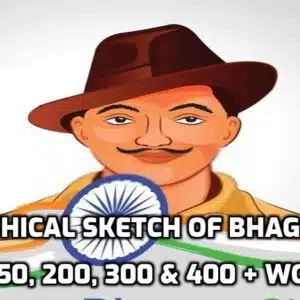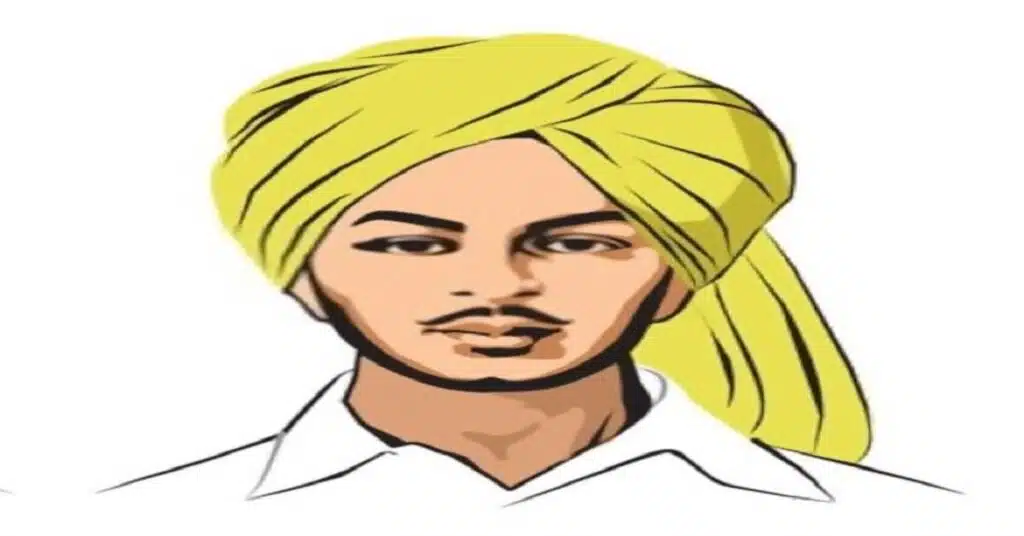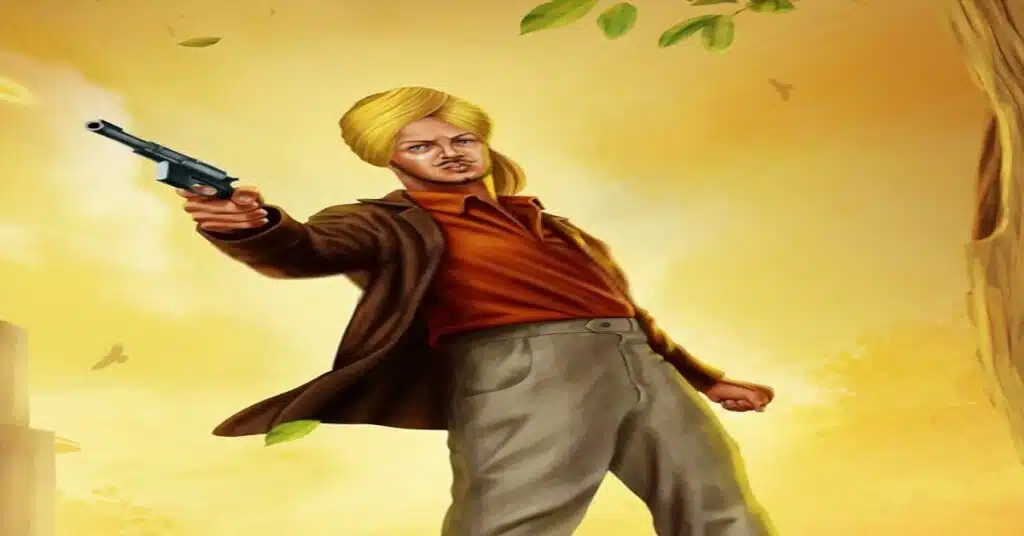
Read the details related to the life of Shaheed Bhagat Singh and then write his bio-sketch.
- Birth: 28, September, 1907, Khatkar Kalan (Punjab).
- Education: at DAV College, Lahore.
- Influenced by: Lala Lajpat Rai and Bhai Parmanand
- Role in Freedom Struggle: Joined the Non-Cooperation Movement while studying in class 9
- Organised the Students’
- Union Started Naujawan Bharat Sabha of Punjab
- Killed Saunders (responsible for attack on Lala Lajpat Rai) along with the help of Sukhdev and Rajguru.
- Exploded bombs in the Central Assembly on April 8, 1929 when Public Safety Bill was introduced in Delhi.
- Imprisoned
- Went on fast for 115 days
- Sacrifice: Sentenced to death in Lahore Conspiracy Case
- Hanged on 23rd March 1931 along with Sukhdev and Rajguru. Bhagat Singh, one of the greatest martyrs of India, was born on 28th September 1907 in village Khatkar Kalan in Punjab. He joined the Non-Cooperation Movement when he was in the ninth class. Then he studied at DAV College, Lahore. He was deeply influenced by Lala Lajpat Rai and Bhai Parmanand. His devotion to the National Movement was quite evident when he organised the Naujawan Bharat Sabha of Punjab. He came in contact with two other great freedom fighters of India, Sukhdev and Rajguru. These three friends killed Saunders who was responsible for the police attack on Lala Lajpat Rai.
Ans:- Bhagat Singh was not ready to tolerate anything done or said against his motherland. He exploded bombs in the Central Assembly on April 8, 1929, when the Public Safety Bill was introduced in the Delhi Assembly. Bhagat Singh was arrested and was put behind the bars. He fasted for 115 days in jail. Bhagat Singh, Sukhdev and Rajguru were sentenced to death in the Lahore Conspiracy Case. On March 23, 1931, they were put to death. Indeed, the life and death of such a great martyr give us great inspiration.
Download the above Biographical Sketch in PDF (Printable)
Also Read:
- Amartya Sen Biography
- Sketch of Dr. B.R. Ambedkar
- John Winston Lennon Biography
- Biography Kiran Bedi
- Subhash Chandra Bose Biography
Biographical Sketch of Bhagat Singh – 100 Words
Bhagat Singh was a great freedom fighter. He sacrificed his life for our comfort. Bhagat Singh is an inspiration to many people even today. He was a symbol of hope in times of difficulties. He also fought for justice. He faced many difficulties and odds. His legacy serves as a reminder that we can all stand up for what is right and just. Bhagat Singh’s legacy of courage, and patriotism will continue to inspire future generations. He offered hope during times of despair. He fearlessly spoke truth to power, even when it meant risking his own life. We should strive to follow his example and work towards making India a better place for everyone.

Bio Sketch on Bhagat Singh – 150 Words
Bhagat Singh was an Indian nationalist and charismatic personality. This revolutionary figure, was born on September 28th, 1907. His birthplace is Punjab’s Banga village. His father’s name was Kishan Singh. He was also a freedom fighter. He instilled a deep sense of patriotism in Bhagat from a young age. At the age of 23, Bhagat emerged as a highly influential figure in India’s struggle for independence.
Bhagat Singh founded the Hindustan Socialist Republican Association (HSRA). Great revolutionaries Chandrashekhar Azad and Sukhdev Thapar were also with him. The aim of this launch was resistance against British oppression.
Despite receiving a death sentence at such a tender age, Bhagat remained steadfast and resolute. He inspired millions of people with his unwavering commitment to his principles. He remained strong even in the face of imprisonment and torture by colonial authorities. His powerful slogans like “Inquilab Zindabad” (Long live the Revolution) continue to resonate. He is considered as a symbol of sacrifice and bravery even today.
Character Sketch of Bhagat Singh – 200 Words
Bhagat Singh was a revolutionary freedom fighter. He played a vital role in the Indian independence movement. From an early age, he expressed his discontent with British rule. He became involved in revolutionary activities. He formed the Hindustan Socialist Republican Association (HSRA). Some other great like-minded individuals also supported him. They wanted to overthrow British rule by any means necessary.
Bhagat Singh’s actions were always rooted in his strong belief in socialism and anti-colonialism. His most notable act was when he threw bombs inside the Central Legislative Assembly. He wanted to protest the Public Safety Bill that curtailed civil liberties for Indians. He was eventually hanged by the British at a young age of 23 years. Bhagat Singh left behind a legacy as one of India’s greatest freedom fighters. His ideas still resonate today among those fighting against oppression and injustice around the world.
In conclusion Bhagat Singh was a revolutionary leader and martyr of the Indian independence movement. His courage, commitment to justice and selflessness left an indelible mark on India’s history. He stands as an example for future generations. He encouraged others to take up the mantle of fighting for what they believe in. Bhagat Singh continues to be remembered today and his legacy is one that will never be forgotten.

Bio sketch on Bhagat Singh – 300 Words
Bhagat Singh, an iconic Indian freedom fighter, was born on September 28, 1907. He hailed from a family of revolutionaries and grew up with a strong sense of patriotism and social justice. Even at the tender age of 12, Bhagat Singh started questioning the oppressive British colonial rule in India.
His passion for independence only grew stronger with time. Actually, he witnessed the outrage shown by the British government against his fellow countrymen. Fueled by this burning desire to free India from colonialism, Bhagat Singh became a prominent member of several revolutionary organizations such as Hindustan Socialist Republican Association (HSRA) and Naujawan Bharat Sabha.
His unwavering commitment to achieving complete independence remains an inspiration to generations even today – making him one of the most respected icons in Indian history!
Even today he remains a symbol of courage and patriotism. His selfless sacrifice and commitment to justice are something that we should all strive towards, even today. By remembering the great contributions, we can continue his work and ensure that future generations have access to freedom and justice. Bhagat Singh’s story is a reminder that the small actions of an individual can have a lasting impact on society. His legacy lives on through his iconic words of defiance and his unwavering commitment to justice.
By choosing to stand up for what he believed in, Bhagat Singh has become an inspiration to millions around the world who still strive for freedom from oppression and tyranny. When we remember Bhagat Singh’s life and struggles, we are reminded that no matter how insurmountable our challenges may seem, there is always hope if we have the courage to fight for what is right.
Bio Sketch on Bhagat Singh – 400 + Words
Bhagat Singh, a name that echoes through the history of India’s freedom struggle. He was a revolutionary who sacrificed his life for the country’s independence from British rule. Bhagat Singh continues to inspire generations with his bravery and unwavering commitment towards the cause of India’s liberation. Let’s dive deep into the life of this remarkable individual, exploring different aspects such as his early years, education, political ideologies, role in Indian independence movement and legacy left behind even after almost 90 years since he was executed by hanging at just 23 years old.
Early life of Bhagat Singh
Bhagat Singh was born into a family of revolutionaries on September 28, 1907, in the village of Banga, Punjab. His father, Kishan Singh, and uncles were actively involved in the freedom struggle against British colonialism.
Growing up under such an environment had a profound impact on Bhagat’s upbringing and personality. He imbibed revolutionary ideals from an early age and developed a strong sense of patriotism towards his country.
At just 12 years old, Bhagat witnessed the Jalianwala Bagh massacre that occurred on April 13th, 1919. This incident proved to be a turning point in his life as he realized the extent of British brutality against Indians.
Despite being born into a financially stable family with access to good education facilities at that time, Bhagat chose to drop out from school after completing matriculation as he believed formal education alone could not bring change for India’s freedom.
Instead, he started spending more time reading books by Indian and foreign socialist thinkers like Lenin and Marx. This further shaped his political views towards socialism and communism which later became integral parts of his revolutionary ideology.
Education of Bhagat Singh
Bhagat Singh, the revolutionary icon of India, was a self-educated individual who had a deep love for books. Even though he did not get formal education past high school due to his involvement in political activities, he never stopped learning.
In his early childhood, Bhagat Singh was enrolled in Dayanand Anglo Vedic High School in Lahore where he completed his matriculation. He was an avid reader from a young age and read extensively on various subjects like history, politics and philosophy.
During his college years at National College in Lahore, Bhagat Singh became more politically aware and active. He spent most of his time reading socialist literature and discussing political issues with fellow students.
Bhagat Singh’s passion for learning continued even after he left college to join the Indian Independence movement full-time. He would often borrow books from friends or visit libraries to quench his thirst for knowledge.
While Bhagat Singh may not have had formal higher education degrees or certifications under his belt, he was an extremely intelligent and well-read individual who valued education greatly.
Political views of Bhagat Singh

Bhagat Singh was a socialist and believed that the British rule in India was unjustified. He saw socialism to eliminate the economic disparities between different classes of society. According to him, true independence could only be achieved if poverty and inequality were eradicated from Indian society.
Singh’s political views were heavily influenced by Marxist ideas, which emphasized class struggle as the driving force behind social change. He saw revolution as necessary for bringing about such change, and therefore advocated for violent means of overthrowing colonial rule.
In addition to his anti-colonial stance, Bhagat Singh was also vocal about issues like women’s rights and caste-based discrimination. His belief in universal equality extended beyond just economic class distinctions.
Despite being critical of Mahatma Gandhi’s non-violent approach towards achieving independence, Bhagat Singh acknowledged Gandhi’s contribution to the freedom struggle. However, he continued to argue that more radical measures were needed for true liberation.
Bhagat Singh’s political views were shaped by his experiences growing up in an oppressed society under colonial rule. His ideology centered around creating a more equal and just society through revolutionary means.
Bhagat Singh’s role in the Indian independence movement
Bhagat Singh was a prominent figure in the Indian independence movement and played a crucial role in India’s struggle for freedom from British rule. He was one of the most influential revolutionaries who advocated for complete independence from British colonialism.
Singh joined the Hindustan Socialist Republican Association (HSRA) at an early age and started participating in various revolutionary activities against the British government. He took part in numerous protests, strikes, and demonstrations to raise awareness about India’s plight under British rule.
One of Bhagat Singh’s notable contributions to India’s freedom struggle was his involvement in the Lahore conspiracy case of 1929. Along with other members of HSRA, he planned to explode bombs inside Central Legislative Assembly as a protest against unfair laws that were imposed on Indians by the British authorities.
Despite being arrested and imprisoned several times during his lifetime, Bhagat Singh remained committed to fighting for India’s independence until his last breath. His sacrifice inspired countless people across India to join him in his fight against colonialism.
Bhagat Singh will always be remembered as a brave revolutionary who dedicated his life towards freeing India from foreign domination. His legacy continues to inspire millions of Indians even today, reminding them that they too can make a difference if they are willing to stand up for what is right.
Execution of Bhagat Singh
Bhagat Singh was captured and imprisoned for his involvement in the murder of British police officer John Saunders. Despite numerous protests and appeals, Bhagat Singh and his fellow revolutionaries were sentenced to death by hanging.
On March 23, 1931, Bhagat Singh along with Rajguru and Sukhdev were executed inside Lahore Central Jail. The execution sparked widespread outrage and protests across India.
Bhagat Singh’s last words were “Inquilab Zindabad” which means long live revolution. This phrase became a rallying cry for Indian independence movements.
The execution of Bhagat Singh did not deter other freedom fighters from continuing their fight for independence. Instead, it further fueled their determination to break free from British colonial rule.
Today, Bhagat Singh is remembered as a martyr who sacrificed his life for the cause of Indian independence. His legacy continues to inspire generations of Indians to fight against injustice and oppression.
Legacy of Bhagat Singh
Bhagat Singh’s legacy lives on to this day, as he remains a symbol of bravery, patriotism and sacrifice. His unwavering determination in the face of adversity inspired many others to join the fight for India’s independence.
His ideas about socialism and revolution also continue to inspire people around the world who are fighting against injustice and oppression. Bhagat Singh proved that even one person with courage and conviction can make a difference in the world.
Today, we remember Bhagat Singh not just as a revolutionary hero but also as an embodiment of our country’s struggle for freedom. He may have been executed at a young age, but his spirit lives on through every Indian who seeks to uphold democracy, justice, and equality.
Let us honor his memory by continuing his fight for a better tomorrow – one that is free from poverty, inequality, and discrimination. Jai Hind!